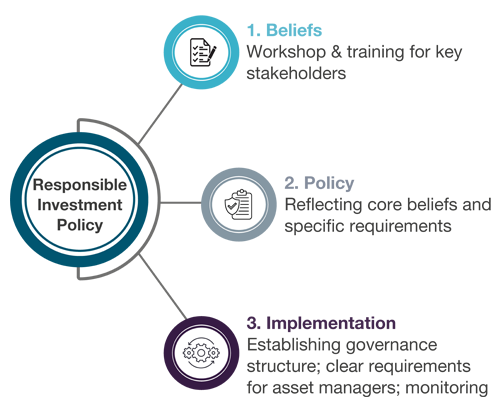- Global Insurer
- 2020
- < USD 10 billion
- Develop first Responsible Investment Policy and support implementation
- ESG Advisory, [Manager research]
Our specialist says:
Sometimes, ESG policies are devised just to meet a compliance need or tick a box, and they can be quite ‘broad-brush’. However, we believe that a clear and well-defined responsible investment policy is key to a robust ESG approach. It is very important that policies reflect the specific views of the investor, since there are different views on what ‘ESG best practice’ should look like. When the team members and stakeholders do not share the same views: training can really help to get everyone on the same page.
Client-Specific Concerns

A mid-sized global insurer was seeking to align themselves with ‘best practice’ in incorporating appropriate Environmental, Social and Governance (ESG) factors into their investment approach. As such, they wanted to develop a Responsible Investment Policy that would be actionable today and set clear milestones for future development. They also needed to ensure that live/future manager searches (including those that were being conducted by bfinance at the time) would reflect the policy.
Coming into this process, senior personnel across the investment team and the wider firm held differing views on ESG and responsible investment matters: which can impede alignment and progress. With the insurance company’s strong focus on Climate Change within its core business activities, the team was also considering whether and how to embed this priority within their investment function.
Outcome
- Dealing with a variety of different ESG beliefs: An initial engagement on high-level Responsible Investment (RI) beliefs revealed a range of views and expectations from different stakeholders. bfinance provided a beliefs workshop and ESG training in order to support improved alignment on key points. This part of the process also considered the firm’s corporate commitments on ESG-related matters, such as reducing carbon emissions, and provided insight on how these might be embedded in the investment approach without compromising on financial returns. These workshop-style meetings also helped to clarify the roles of the various stakeholders and their involvement in investment decision-making.
- Supporting ‘best practice’: It was important to develop a clear and robust approach to ESG integration beyond simply introducing a Policy. This included: establishing an ESG governance structure, setting out a plan of action to achieve future goals and identifying appropriate ESG bodies/initiatives with which the firm could engage in order to support their continued journey.
- Setting clear requirements for asset managers: With substantial use of external asset managers, the investor would essentially require its partners to support the implementation of their ESG approach. The RI policy not only described the investor’s ESG beliefs and requirements overall but also clearly defined the investor’s specific expectations for asset managers in terms of their processes, capabilities and reporting. This included specific details for different asset classes, since ESG capabilities and reporting are not uniform across the investment landscape.


 Français (France)
Français (France)  Deutsch (DACH)
Deutsch (DACH)  Italiano (Italia)
Italiano (Italia)  Dutch (Nederlands)
Dutch (Nederlands)  English (United States)
English (United States)  English (Canada)
English (Canada)  French (Canada)
French (Canada) 
